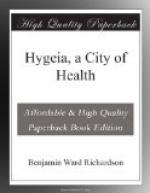Our city, which may be named Hygeia, has the advantage of being a new foundation, but it is so built that existing cities might be largely modelled upon it.
The population of the city may be placed at 100,000, living in 20,000 houses, built on 4,000 acres of land,—an average of 25 persons to an acre. This may be considered a large population for the space occupied, but, since the effect of density on vitality tells only determinately when it reaches a certain extreme degree, as in Liverpool and Glasgow, the estimate may be ventured.
The safety of the population of the city is provided for against density by the character of the houses, which ensures an equal distribution of the population. Tall houses overshadowing the streets, and creating necessity for one entrance to several tenements, are nowhere permitted. In streets devoted to business, where the tradespeople require a place of mart or shop, the houses are four stories high, and in some of the western streets where the houses are separate, three and four storied buildings are erected; but on the whole it is found bad to exceed this range, and as each story is limited to 15 feet, no house is higher than 60 feet.
The substratum of the city is of two kinds. At its northern and highest part, there is clay; at its southern and south-eastern, gravel. Whatever disadvantages might spring in other places from a retention of water on a clay soil, is here met by the plan that is universally followed, of building every house on arches of solid brickwork. So, where in other towns there are areas, and kitchens, and servants’ offices, there are here subways through which the air flows freely, and down the inclines of which all currents of water are carried away.
The acreage of our model city allows room for three wide main streets or boulevards, which run from east to west, and which are the main thoroughfares. Beneath each of these is a railway along which the heavy traffic of the city is carried on. The streets from north to south which cross the main thoroughfares at right angles, and the minor streets which run parallel, are all wide, and, owing to the lowness of the houses, are thoroughly ventilated, and in the day are filled with sunlight. They are planted on each side of




